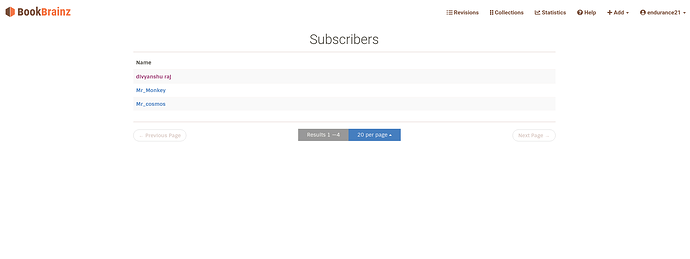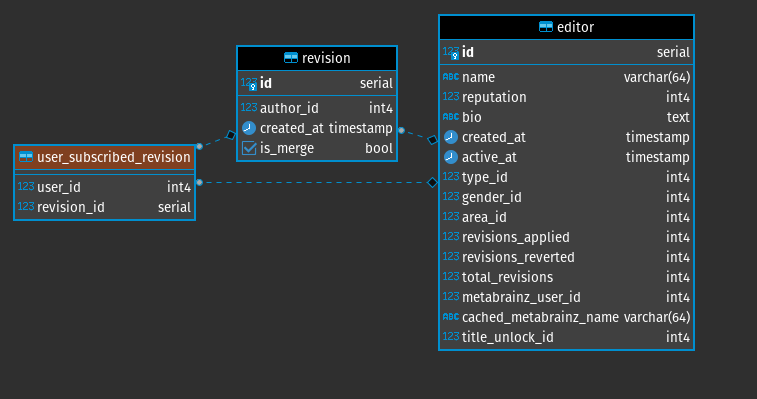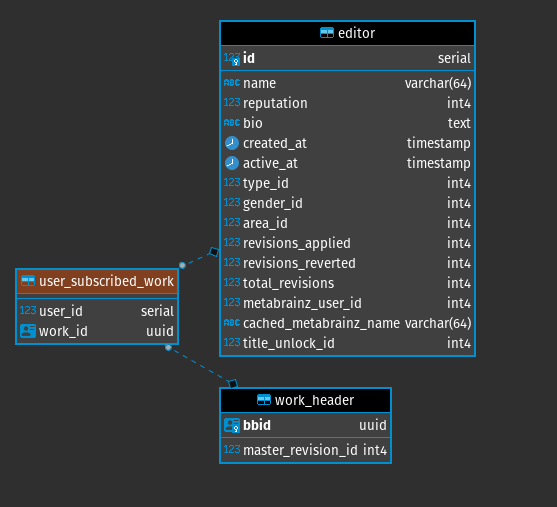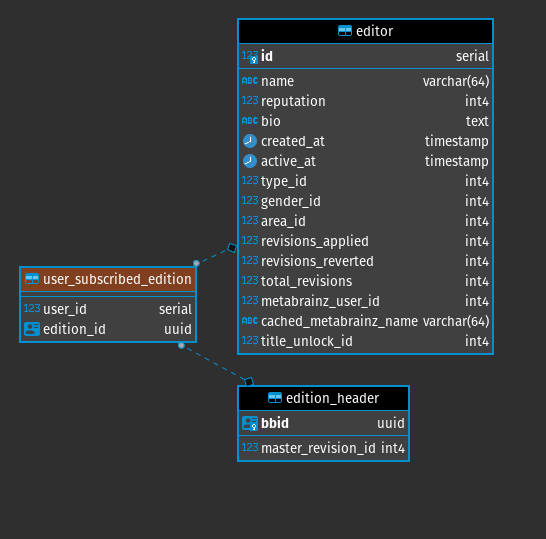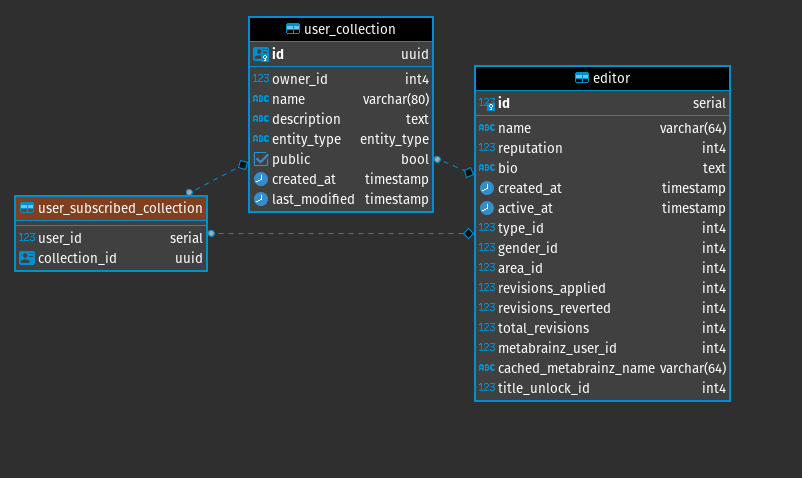Here is my Draft Proposal for GSOC 21 @BookBrainz on the topic : Add subscriptions and email notifications
The usecase of BookBrainz has been increasing and the graph of number of users is going up day by day, For a user to manage and catchup the edits they make, the entity they create or to follow another artist, user, group, publisher , becomes so much tough and one would feel the need of an assistant to manage those things , though keeping an assistant is not affordable at all ![]() , nevertheless this project aims to provide the ease by contantly reminding the users through email about things they want to follow and manage.
, nevertheless this project aims to provide the ease by contantly reminding the users through email about things they want to follow and manage.
Main Features included :
- A user wil be notified by default when their is new note on revisons they make or they subscribe
- A user can also choose to subsribe other user, work, edition, edition-groups, publisher, collection( public ) explicitly
- Extended goal includes establishing user preference over this default controls.
Frontend changes
Easy access to subscriptions listing

- This would facilate easy and fast access to users subscriptions
- proper icon will be placed instead of that same as of sigout icon
subscriptions listing
- can use the idea of collection table to list the subscriptions
- a checklist and a button to unscribe the multiple subscriptions would be there
- keeping and removing of table fields are subjected to discussions ahead.
- pager component will be reused

subscriber listing
- will list all the editors( a BB user ) who have subscribed to the edits that we are making
- listing may also include some specific works of ours that has been been suscribed.
- For the intial goal only users who are suscribers of us will be displayed in a table
- pager component will be reused

Subscribing/UnSuscribing a user
-
A BB user (editor ) can subscribe/Unsuscribe to the other editor by a simple buton interface
-
Likewise a simple button would placed for each of other entity ( TO DO )
- Work
- Edition
- Edition Group
- Author
- Publisher
- Collection
DATABASE Changes
There will be total 8 new table , because we will have 7 relation with editor(user) → entity, where entities are ( revisions,author, work, editon, editon_group, publisher, collection ) + 1 for user–>user subscription
They will be like :-
user_subscribed_<entity_type>
1 ) user_subscribed_revision
ORM:
CREATE TABLE bookbrainz.user_subscribed_revision(
user_id serial NOT NULL,
revision_id uuid NOT NULL,
CONSTRAINT user_subscribed_author_fk FOREIGN KEY (user_id) REFERENCES bookbrainz.editor(id),
CONSTRAINT user_subscribed_author_fk_1 FOREIGN KEY (author_id) REFERENCES bookbrainz.revision(id)
);
2 ) user_subscribed_author
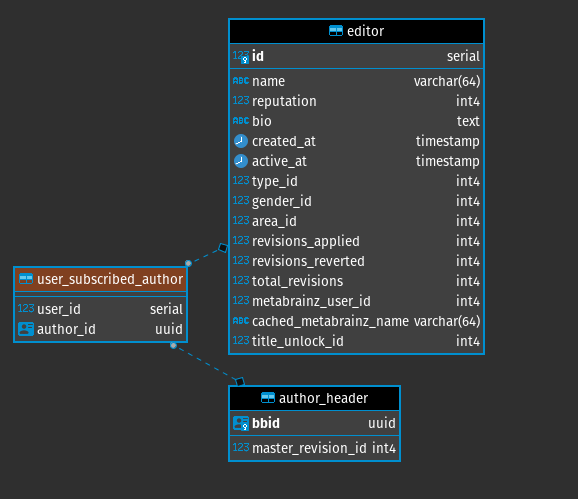
ORM :
CREATE TABLE bookbrainz.user_subscribed_author (
user_id serial NOT NULL,
author_id uuid NOT NULL,
CONSTRAINT user_subscribed_author_fk FOREIGN KEY (user_id) REFERENCES bookbrainz.editor(id),
CONSTRAINT user_subscribed_author_fk_1 FOREIGN KEY (author_id) REFERENCES bookbrainz.author_header(bbid)
);
3 ) user_subscribed_work
ORM:
CREATE TABLE bookbrainz.user_subscribed_work (
user_id serial NOT NULL,
work_id uuid NOT NULL,
CONSTRAINT user_subscribed_work_fk FOREIGN KEY (user_id) REFERENCES bookbrainz.editor(id),
CONSTRAINT user_subscribed_work_fk_1 FOREIGN KEY (work_id) REFERENCES bookbrainz.work_header(bbid)
);
4) user_subscribed_edition
ORM:
CREATE TABLE bookbrainz.user_subscribed_edition (
user_id serial NOT NULL,
edition_id uuid NOT NULL,
CONSTRAINT user_subscribed_edition_fk FOREIGN KEY (user_id) REFERENCES bookbrainz.editor(id),
CONSTRAINT user_subscribed_edition_fk_1 FOREIGN KEY (edition_id) REFERENCES bookbrainz.edition_header(bbid)
);
5 ) user_subscribed_editon_group
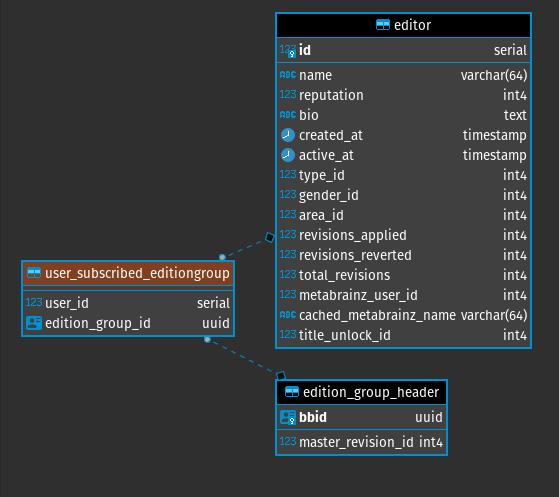
ORM:
`CREATE TABLE bookbrainz.user_subscribed_editiongroup (
user_id serial NOT NULL,
edition_group_id uuid NULL,
CONSTRAINT user_subscribed_editiongroup_fk FOREIGN KEY (user_id) REFERENCES bookbrainz.editor(id),
CONSTRAINT user_subscribed_editiongroup_fk_1 FOREIGN KEY (edition_group_id) REFERENCES bookbrainz.edition_group_header(bbid)
);
6 ) user_subscribed_publisher
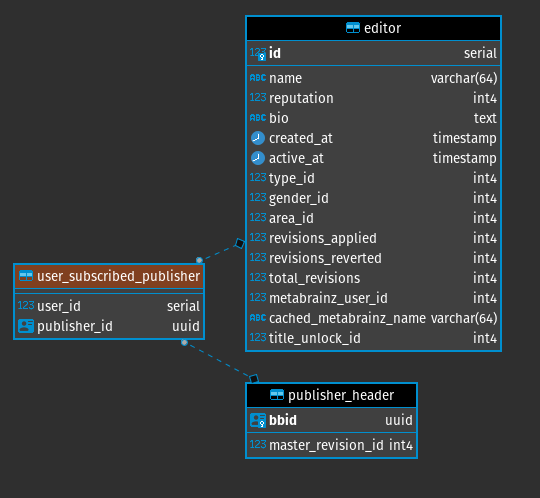
ORM:
CREATE TABLE bookbrainz.user_subscribed_publisher (
user_id serial NOT NULL,
publisher_id uuid NOT NULL,
CONSTRAINT user_subscribed_publisher_fk FOREIGN KEY (user_id) REFERENCES bookbrainz.editor(id),
CONSTRAINT user_subscribed_publisher_fk_1 FOREIGN KEY (publisher_id) REFERENCES bookbrainz.publisher_header(bbid)
);
7 ) user_subscribed_collection
CREATE TABLE bookbrainz.user_subscribed_collection (
user_id serial NOT NULL,
collection_id uuid NOT NULL,
CONSTRAINT user_subscribed_collection_fk FOREIGN KEY (user_id) REFERENCES bookbrainz.editor(id),
CONSTRAINT user_subscribed_collection_fk_1 FOREIGN KEY (collection_id) REFERENCES bookbrainz.user_collection(id)
);
8 ) user_subscribed_user
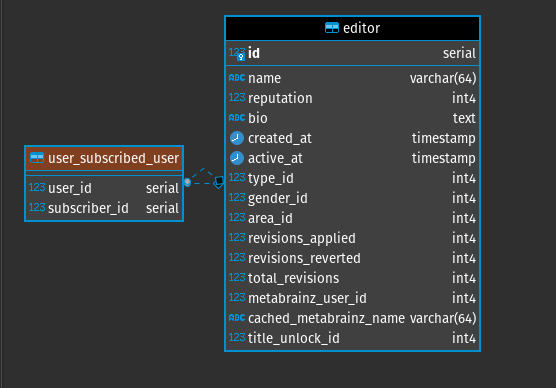
ORM:
CREATE TABLE bookbrainz.user_subscribed_user (
user_id serial NOT NULL,
subscriber_id serial NOT NULL,
CONSTRAINT user_subscribed_user_fk FOREIGN KEY (user_id) REFERENCES bookbrainz.editor(id),
CONSTRAINT user_subscribed_user_fk_1 FOREIGN KEY (subscriber_id) REFERENCES bookbrainz.editor(id)
);
Setting Up a MAILER
Establishment of A BB dedicated mailer to deliver all our mails to the subscriber is already under progess , almost a step away ![]()
Here i have raised a PR for the same ![]()
It uses :-
- Nodemailer ( our mailer agent )
- SMTP server
APIs :
subscribe
- app.get(‘/subscribe/revision/:revisionId’, controller)
- app.get(‘/subscribe/user/:userId’,controller)
- app.get(‘/subscribe/entity_type/:id’,controller) ( will handle user—>entity subscription, entity can be any of 6)
Unsubscribe
- app.get(‘/unsubscribe/revision/:revisionId’, controller)
- app.get(‘/unsubscribe/user/:userId’,controller)
- app.get(‘/unsubscribe/entity_type/:id’,controller) ( will handle user—>entity subscription, entity can be any of 6)
MECHANISM OF MAILING
1) user_subscribed_revision
Suggested by @CatQuest , whenever a user make revision to any entity then they should automatically be added to user_subscribed_revision table and they should recieve email if anyone comments ( add note) on that revision .
- whenever a user hits the endpoint “/revisions/:id/note” the controller will find the subscribers of that revision from user_subscribed_revision table using revision_id and then send them mail.
2) user_subscribed_entity
Suppose a user subscribes a work entity ,I have assumed following mechanism in order to process subscription :-
- Any changes made to that entity will count as its revision , so whenever a new revision happens we will seek to the database user_subscribed_work database to find all its subscribers (BB user)
- We will find what we need to send in email by followig method :-
- work_revision table contains data_id column
- using that data_id we will find the final state of work and then
- Either we can list the changes made to the email body or simply we can use edit-note entered by user while editing the work entity + link of that revision
- And finally Use the mailer to send the mail to subcribers.
Likewise we will do the same for rest of entity( author, edition, edition_group, publisher, collection).
3) user_subscribed_user
From the discussio so far i have come to conclusion that , any entity modification ( create , delete , revision ) by the user will ultimately be notified to the its subscribers .
Scaling
The best way to scale our system is to scale it horizontaly and establish task-ques to store the jobs to be in bulk and to be processed by separate mailing service.
- I have a flowchart for the same :-
Setting Up RabbitMQ
- RabbitMQ will be setup using its docker image
- I have decided to setup this during community bonding period with some guidance of mentors
connection with RabbitMQ
- Will use
ampqlibinterface to do so
connect.js
import Interface from 'amqplib'
let channel = Interface.connect(URI)
.then( (connection)=>{ return connection.createChannel() })
.catch((error)
=>{ throw error})
export default channel
// this connection will be utillized by publisher and consumer to que and deque the jobs respectively
Publisher
publisher.js
import channel from 'connect.js'
const queName = 'subscriptions'
let job1 = {
email_id:endrance21@gmail.com // users email will be found by looking into `users table`
message:"some message body to be sent",
}
channel.assertQueue(queName)
.then(()=>{
channel.sendToQueue(queName,Buffer.from(JSON.stringify(job1) ,{ persistent: true } ); // will send jobs to the que
})
.catch(()=>{
//handle error !
})
Consumer
consumer.js
import channel from 'connect.js'
import mailer from "mailer.js"
const queName = 'subscriptions'
channel.assertQueue(queName)
.then(()=>{
return channel.consume(queName); // will consume jobs to the que
})
.then((job)=>{
let {content } = job;
let body = JSON.parse(content) ;
let {email,message} = body
mailer.sendMail({email,message}); //this will simply send mail to the given email
})
.catch(()=>{
//handle error !
})
Preferences :
For now :
- An user creating any entity wil automatically be subscribed to it using above apis
- If a user comments or edits any entity then they wil be automatically subscribed to that revision.
- An user can see others subscriptions and subscribers
Extended goal
Is To provide a prefernce page to user to decide if they want to subscribe to or not to their created entity or revison they make or any comment they make on any revison .
- user_preference table will be created
- columns will be decided according to prefernce type but they all will be type of bool .
- Apis to update the preference
- app.put(‘/preference/update’,controller)
- Payload will contain the final state of preference table collected through user via checkbox ui
- app.get('/preference/,controller)
- This will fetch the current state of user_preference table and used to display on users profile
- according to current state of prefernce_table controller will unscribe/subscribe entities .
Detailed information about yourself
Tell us about the computer(s) you have available for working on your SoC project!
A lenevo Legion ( i7, 10 gen + 24GB of RAM) , Separate Monitor along with laptop for multitasking
When did you first start programming?
In My freshmen year of College , i made a Audio Analyser tool using Vanilla JS.
What type of books do you read?
IT ENDS WITH US by COLLEEN HOOVER , NOVEMBER 9 by COLLEEN HOOVER AND IN Non-Fictious I have read ORIGINALS by ADAM GRANT
Have you contributed to other Open Source projects? If so, which projects and can we see some of your code?
I participated in GSOC 2020 as Student Developer , here is the work Product ![]()
How much time do you have available, and how would you plan to use it?
Official GSoC period is from June 7th to 16st August, during the vacation, I will be devoting most of my uptime to this project, 45-50 hrs a week, after re-opening of my college in July, I will be devoting 25-30 hrs a week.
TO DO’s
- Code snippets
- Gsoc timeline
- Error handling and managing enqueing system
Thank You ! ![]()

